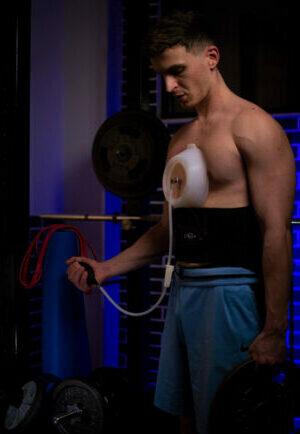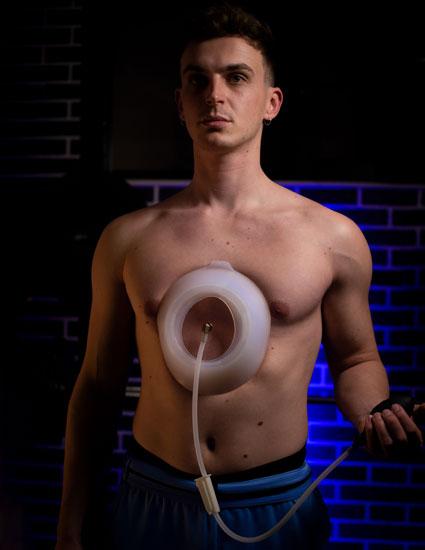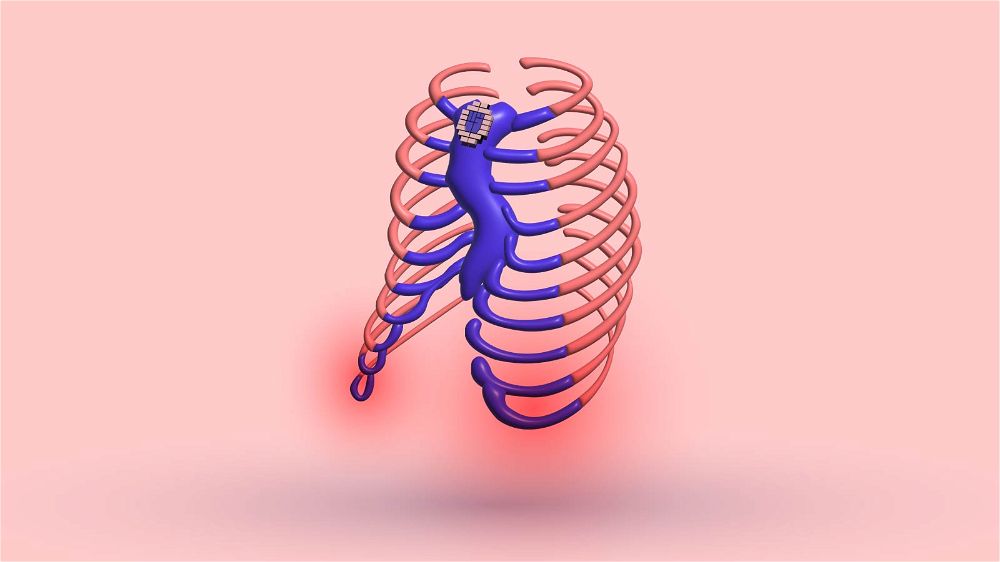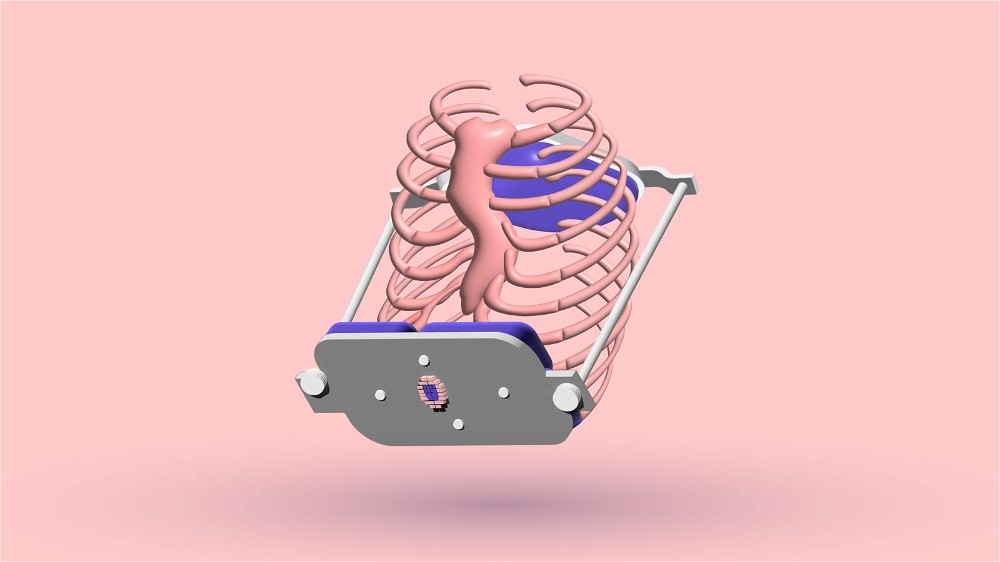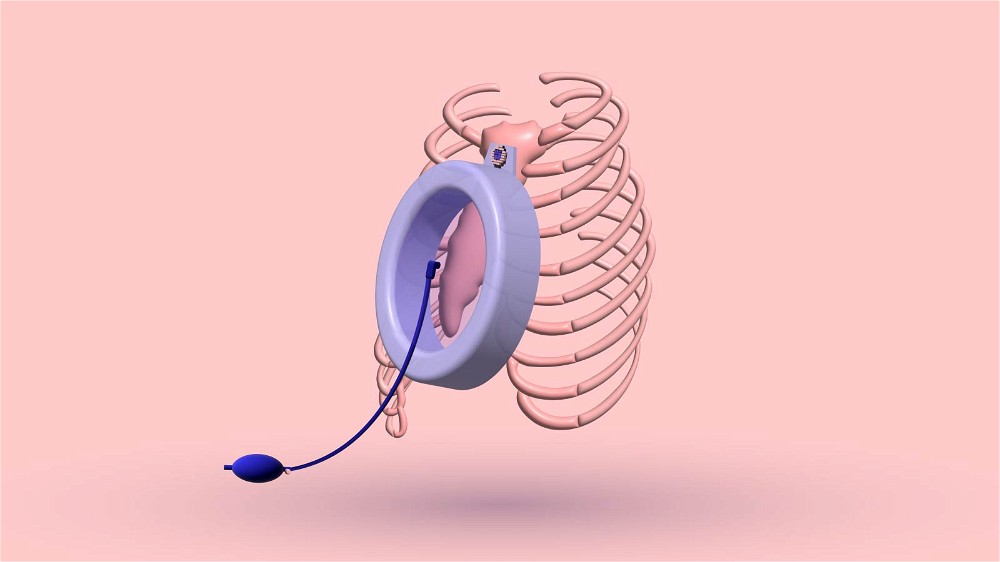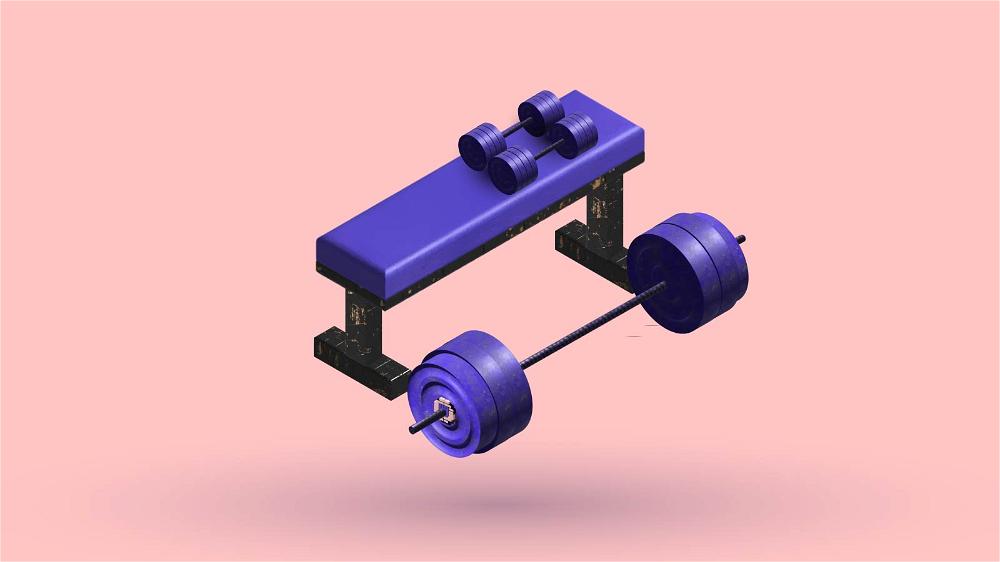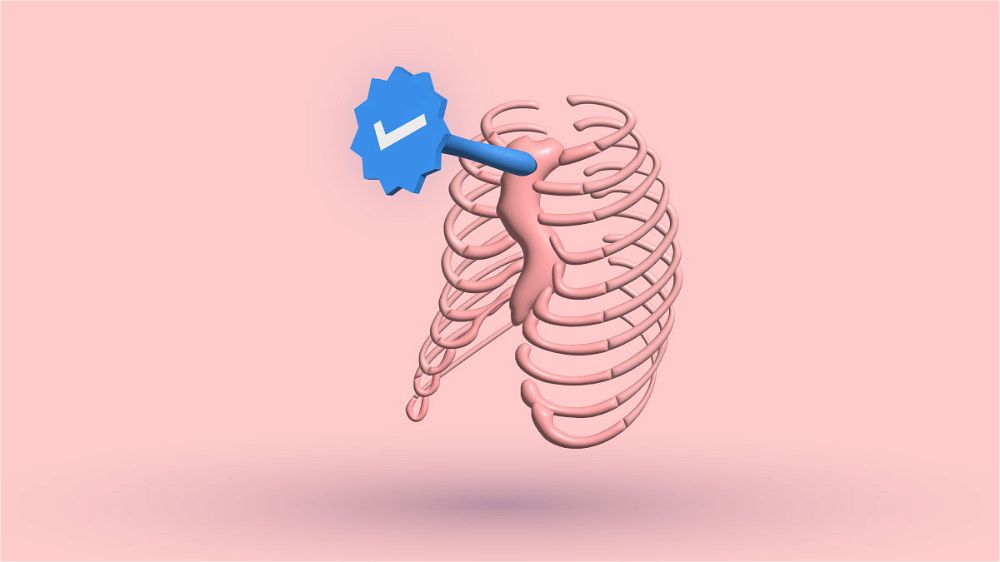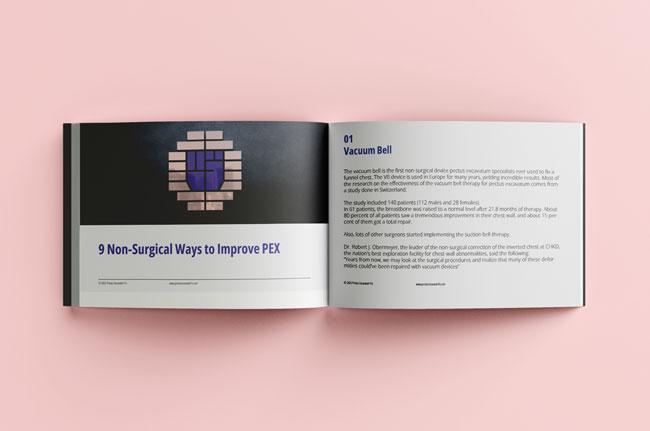Lately, there has been a growing interest in the non-surgical treatment of pectus carinatum, such as bracing, because of surgical difficulties.
The anterior chest wall is still flexible during adolescence, which makes the correction process of the Dynamic Remodeling bracing method much more effective and painless.
Various procedures for rebuilding the chest wall are available. But orthotic bracing has produced some of the most effective results, making it the most famous non-surgical treatment for pectus carinatum.
Surgery Can Be Inferior to Bracing Therapy
The most common therapy for pectus carinatum is surgery. Surgical treatment offers positive results most of the time, although it is a challenging and painful procedure. Resection of the deformed cartilage is the most common surgical therapy for pectus carinatum.
The biggest problem is that this might end with a large operative scar across your chest, often making your chest appear worse than it was preoperatively. Also, surgery can cause a lot of discomforts.
Don't Waste Your Precious Time
Pectus carinatum can cause severe cardiac symptoms, including palpitations, dyspnea, and wheezing due to chest wall stiffness. Most patients seek surgical repair to flatten the chest and improve chest appearance.
That will also improve the patient's self-confidence. It is hard to live with chest wall deformities, and I always suggest improving them. Don't let your body suffer, and do not waste precious time.
Generally, the older you get, the stiffer your chest deformity gets, correcting with bracing is more difficult. Always seek medical and professional help if you struggle to breathe deeply or experience a rapid heart rate.
Bracing is Effective
In cases with pectus carinatum, the use of orthotic bracing, pioneered by Sydney Haje in 1977, is gaining recognition as an alternative to surgery due to the fear of surgery of most people.
A chest-wall brace provides direct pressure on the deformed portion of the chest. This solution is very effective in children, teens, and young adults with pectus carinatum who want to avoid surgery. It is effective for both males and females.
There are plenty of cases where even adults with stiffer chests managed to fix their deformities with bracing. The willingness to wear the brace as needed is critical to the effectiveness of this therapy method. Braces have front and rear compression plates held together by aluminum bars.
It is crucial for someone with this deformity to be aware of the effectiveness of this conservative method. According to The Calgary protocol for bracing Pectus carinatum, bracing has successfully treated over 5000 people since 1992.
What Research Shows
There are now plenty of studies about the effectiveness of the bracing method. One of them is in Soonchunhyang University Cheonan Hospital, in South Korea.
In this study, physicians treated 206 patients with pectus carinatum with a compressive brace over six years. The patients who wore the brace every day for almost 24 hours noticed the fastest improvements.
However, the brace removal is not done instantly. It needs to happen gradually. The wearing time of the braces should lower progressively until the patient doesn't need the brace anymore. Despite delayed removal of the bracing, recurrence of the deformity happened rarely.
Six of 119 patients who wore the brace 24 hours a day reported recurrence 2–5 months after removal. They were encouraged to wear the brace again. Within three months of removing the compressive brace, the six patients who suffered recurrence were re-corrected by re-wearing it.
Bracing Therapy History
Dr. Sydney Abrao Haje treated his first patient with a Dynamic Compression Brace in 1977. There was enough time for medical scientists to evolve, bracing well since then.
In 1993, the first case report on using orthotic braces to treat pectus carinatum deformity was published. Mielke and Winter reported an outstanding outcome in an 8-year-old child treated for an aesthetically unacceptable pectus carinatum deformity with bracing for around 16 months.
Other publications are showing comparable results with orthotic bracing for pigeon chests. Also, some studies show custom-made braces may help with extremely apparent pectus abnormalities.
Brace Creation Process & Materials Used
The creation of these orthoses is a straightforward process. There are usually a few available premade pectus carinatum braces. But, doctors say that they prefer to custom manufacture each patient's orthosis. Custom manufacturing ensures a lower form and more comfortable orthosis with fewer skin breakdown issues.
The bulge has a thermoform and border, and it's made with a soft interface of a hard substance such as high-density polyethylene or copolymer. The metal anterior and posterior bands are in a precise shape before being coated with heat shrink tubing, giving enough room for compression.
These are joined on either side by ladder buckles that adjust the compression. The arrangement of these buckles and ladder straps gives the patient track of the compression and raises to regular intervals.
Patient Responsibility is Very Important
After constructing a personalized brace, everything is in the patient's hands now. The patient's responsibility to wear and apply the braces right is the key in the process.
The best period to begin bracing is early in adolescence. Patients are usually recommended to wear the brace for 23 hours a day, for three to six months, or until the deformity is gone.
After then, for the next 3 to 6 months, the brace should be worn for 16 hours a day, allowing the patient to participate in school activities without the braces.
Maintenance Phase
The maintenance phase can begin when the desired look is achieved and the patient is satisfied with the appearance. With overnight regular brace usage, you need to re-evaluate every third month to verify that your deformity is under control until linear growth stops. All patients should have their orthoses re-evaluated to confirm that they fit correctly.
Compressive bracing improves pectus carinatum appearance subjectively and objectively in skeletally immature individuals. On the other hand, patient compliance and attentive follow-up appear to be critical for the effectiveness of this therapy technique.
More research is needed to establish that this therapy strategy is long-lasting. The brace allows total arm movement and can even allow you to exercise. And in the end, I have to mention that here are a couple of reasons why you require a prescription for braces. But most important for me is that a qualified medical professional must supervise the process.
Price
Another major part is the price. For example, the total cost of the brace in Canada is $1,325.00, while fees outside Canada are $1,425.00. These prices include all appointments and routine clinical costs.
Kids
When it comes to kids, all the responsibility is put on the parents.
You must first explain to your kids that all of that is for better health. Be careful how you tell them, choose the words wisely.
The kid's motivation and compliance are essential. But, the most important about kids is significant parental support. You, as a parent, have to care about your kid's mental health through these times.
Most children will need to wear a brace for 6 to 12 months. Others may require it for longer, throughout the child's teen years. They can take it off for sports, showering, and other activities, but they must wear it for at least 8 hours daily.
Help your child with the brace as directed by the doctor. The majority of children tolerate their braces well. Under a shirt, the brace is typically undetectable. However, if your child is having difficulties, try to be understanding.
Come up with solutions and rewards with your child to convince them to wear the brace. This period may be difficult for you, but please be patient. Also, set aside a "night off" to let the child feel unrestricted.
The extensive analysis of brace wear revealed that non-surgical therapy with a compressive brace in patients with pectus carinatum, especially in adolescents and teenagers, was very effective.
8 Things That You Need to Know
Wearing the brace usually does not cause any issues, other than skin reddening and rashing occasionally.
- The redness persists after removing the brace for at least 30 min.
- Under the brace, you can develop blisters, sores, or a rash.
- The brace is a slim and lightweight tool applied to the ribcage.
- The brace exerts pressure on the deformed ribcage and allows the ribcage to remodel over time for a permanent outcome.
- For the best comfort and effectiveness, get a personalized brace.
- For the treatment to succeed, you must wear it almost every day.
- Minimal treatment time: 8 weeks.
- All the information is universal but please remember that everybody's deformity is different, and every brace must be personal.
Increased Confidence
Correcting the malformation helps you improve posture and self-image. Besides, it can help with breathing difficulties and improve cardiopulmonary function.
Bracing Therapy Step-by-Step
- Pressure measurements of chest wall flexibility are part of the evaluation.
- Individually custom-made brace for all sorts of pigeon chests.
- Correction of the pigeon chest and brace fitting with modifications are part of the brace fitting process.
- The brace is required to be worn for the first eight weeks.
- After eight weeks, the brace is removed for 1-2 hours each day.
- After 12 weeks, the brace is gradually removed.
- By 24 weeks, the brace is only worn for 12 hours every day.
- The brace is only used for maintenance by week 32.
- After week 40, the bracing program comes to an end.
Conclusion
There are plenty of pectus carinatum correction methods. Some are surgery, bracing, different tools, and corrective exercises. A brace seems like a good solution for those having difficulty with their body image and self-confidence.
Brace therapy does not need general anesthesia or surgery, and there is no surgical scar. It is also less expensive, and the outcome is comparable to a surgical one. The treatment of pectus carinatum with braces does not have a rigorous protocol.
All you need to do is be consistent with wearing the brace. Brace treatment has had positive results and can help in avoiding surgical problems. Because of these factors, bracing was chosen as the first-line therapy for pectus carinatum.
The surgical procedure is an option for patients who are not complying with the brace therapy. I suggest to you the most remain positive throughout your experiences. Be hopeful that you can improve your deformity non-surgically.
All these studies give us the confidence to go through the treatment with the hope of a positive outcome.
Self-love involves living a healthy lifestyle, working out, and practicing breathing techniques. Searching for a solution to your problem and chest deformity is a sort of self-love since you are giving yourself the gift of enhanced self-esteem.
You will quickly see the advantages of having better self-esteem and more self-confidence when you journey to correcting your chest deformity non-surgically. Thank you for reading!
5 Sources
- Lee SY, Lee SJ, Jeon CW, Lee CS, Lee KR. Effect of the compressive brace in pectus carinatum. European Journal of Cardio-Thoracic Surgery. 2008 Jul 1;34(1):146–9.
- Pectus carinatum. In: Wikipedia [Internet]. 2022 [cited 2022 Dec 5]. Available from: https://en.wikipedia.org/w/index.php?title=Pectus_carinatum&oldid=1108040733
- Pectus carinatum – Frequently asked questions | Braceworks Custom Orthotics [Internet]. [cited 2022 Dec 5]. Available from: https://braceworks.ca/2021/10/06/devices/torso/pectus-carinatum/pectus-carinatum-faqs/
- Nehra D, Ein SH, Tlumacki M, Masiakos PT. Pectus Carinatum: To Brace or Not to Brace—A Picture Is Worth 1770 Words. JPO: Journal of Prosthetics and Orthotics. 2009 Jul;21(3):167–70.
- The Calgary protocol for bracing of pectus carinatum: A preliminary report | Braceworks Custom Orthotics [Internet]. [cited 2022 Dec 5]. Available from: https://braceworks.ca/2017/05/07/devices/torso/pectus-carinatum/calgary-proto-pectus-carinatum-preliminary/


